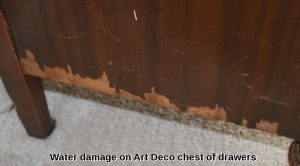As you ponder ways to beat the summer heat, don’t forget your antique furniture. High temperatures, humidity, water and direct sunlight can alter both the appearance and structural integrity of most 18th and 19th century furniture. Over time, these conditions can destroy patina and reduce value.
Here’s what you can do now to protect your family heirlooms:
- Adjust Heat and Humidity: While the Library of Congress suggests a constant relative humidity (RH) of 35-50 percent and temperatures of 65-70 degrees Fahrenheit for the proper storage of antique objects, consistency is arguably more important than maintaining a museum setting. The key is to avoid environmental extremes. Fluctuations in temperature and humidity will cause antique furniture joints and drawers to swell, loosen and crack over time. And since many early furniture joints were secured with hide glue, the constant motion resulting from expansion and contraction can cause the old glue to fall from the joints. Factor in the absorption and loss of moisture from changes in RH, and antique table tops and side panels will separate along the grain.
- Most homeowners can maintain an acceptable—and comfortable—room temperature with the aid of an air conditioner and humidifier. Antique furniture will survive intact in temperatures of 70-72 degrees Fahrenheit and RH of 50 percent. Keeping the humidity and temperature at manageable levels can be solved with the purchase of a $10 thermometer & hygrometer. Most importantly, don’t store your antique furniture in a garage, attic or shed.
- Check Location: Most collectors understand the adverse effects that result from exposing paintings and textiles to Ultraviolet light, but they often forget that their antique furniture is also at risk. Placing an antique settee in a sunroom or solarium will lead to sun fading over time. Upholstery, hand painted decorations, natural finishes and designs will gradually lighten and eventually disappear. Although UV film can reduce this effect, moving the furniture out of direct sunlight is a much safer alternative.
- Prevent Water Damage: Water stained furniture is a constant problem and one that can be easily avoided. Resisting the temptation to place planters on antique tables and stands, including Victorian marble top furniture, can save you a costly refinishing or conservation job. Even placing planters on trivets might not save your furniture. Water damage from direct contact and condensation beneath trivets will leave water bloom and water rings on old finishes. Moreover, long term exposure to moisture will result in surface separations, veneer buckling, and mold growth.
Taking a few simple precautions now can save your family heirlooms for the next generation.








